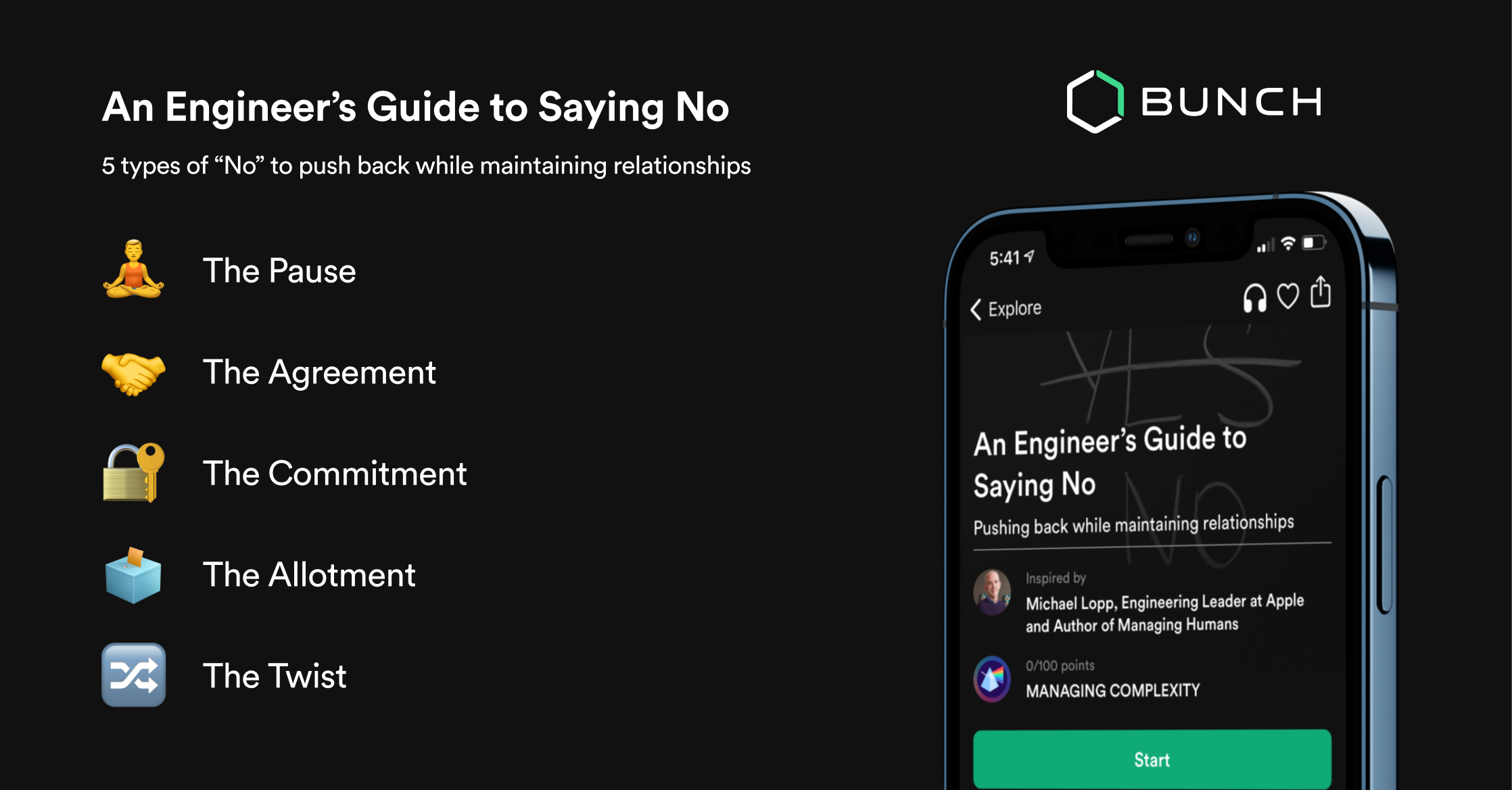There you are: the all-reliable engineer. You code at lightning speed, ship fixes quickly, juggle tons of meetings, and squash bugs with ease. Your team has learned to rely on you, and who can blame them?
But what if things look too much like this lately?
- When you’re out, things seem to break
- You continue coding past your working hours
- You get pulled into meetings and you don’t really need to be there
- Your Product team is waiting on you to build out new features, but you’re still behind on work from last week
It’s likely that you’ve learned to team-please long before management was part of the question. Now, your difficulty to say “no” is getting in your way.
Saying “no” can be revolutionary
“No” is often equated with being mean or unhelpful. But this isn’t really the case.
Let’s take a look at some of the major issues engineers face:
- Getting behind on the roadmap
- Being given a project without many details
- Dealing with people who don’t really know what they want
- Committing to something, and then not being able to do it, because it actually takes longer than expected
- Being told to compromise on quality, and then getting blamed for bugs
“No” isn’t about shutting projects and people down. In fact, using “no” is one of the best ways to support your team, manage your workload, and meet your goals.
The 5 No’s You Need
Here’s a list of the 5 no’s you can be using more of at work, when to use them, and why they’re useful.
By the way, you can keep this framework and discover others to help you become an excellent technical leader by downloading BUNCH on the App Store.

The Pause
Here’s how to do it: “Let’s take a step back and map out what needs to be done. I can’t commit to anything until we have a clear understanding of the task.”
Use it when: People are racing ahead to get things done, but haven’t thought through what’s actually required.
Why it works: According to Managing Humans author Michael Lopp, this tactic forces everyone to slow down and think: “Saying no is saying “stop,” and in a valley full of people who thrive on endless movement, the ability to strategically choose when it’s time to stop is the sign of a manager willing to defy convention.”
The Agreement
Here’s how to do it: “Let’s prioritize this and de-prioritize the project we talked about last week. We can’t fit both, and this will have a bigger impact.” You’re basically saying: If we do X, we must do Y.
Use it when: The core idea is good, but project timelines need shifting.
Why it works: Camille Fournier, author of The Manager’s Path: A Guide for Tech Leaders Managing Growth and Change, explains: “Responding with positivity while still articulating the boundaries of reality will get you into the major leagues of senior leadership”. If you want to get on your stakeholders’ good side, this is the way!
The Commitment
Here’s how to do it: “Realistically, I can’t take this on because I wouldn’t be doing it justice. I’m already working on the migration.”
Use it when: You have too many things on your plate and won’t be able to dedicate the time needed.
Why it works: Showing that you’re true to your word shows others they can rely on you. Take it from Alex Weber, CGO at N26: “It’s things like being conscious of what you can and cannot do, and never promising more, that build trust with your team.”
The Allotment
Here’s how to do it: “The feature request I’m working on will take another 3 hours. I also have a bug fix that’ll take 45 minutes, and a refactor that will take 4 hours. As you can see, what you’re asking me to do won’t fit.”
Use it when: You’re crunched for time and the new project/ task literally doesn’t fit.
Why it works: Showing how long each task takes boosts your credibility and demonstrates ownership. This gives your stakeholders and team an insight into what’s involved and shows them that, when you say no, you have time estimates to justify it.
The Twist
Here’s how to do it: “I think that’s a good idea, but it doesn’t fit in the roadmap as is. What if it looked like {this}?”
Use it when: What’s being asked of you is unrealistic, and you want to get to the root of the idea.
Why it works: This helps your team see new possibilities instead of getting caught in a one-size-fits-all solution. Stever Robbins, serial entrepreneur and co-founder of FTP Software, says questions engage others and reveal more innovative solutions.
Make “no” part of your legacy
The more we use “no” in an effective way, instead of a negative or demeaning way, the more we have the power to meet deadlines, build trust on the team, and meet our goals. So the next time someone asks you to do something, instead of jumping to accommodate it and potentially putting other things at risk, remember the power “no” holds.
Want to 10x your impact? Download the Bunch AI Leadership Coach app.


